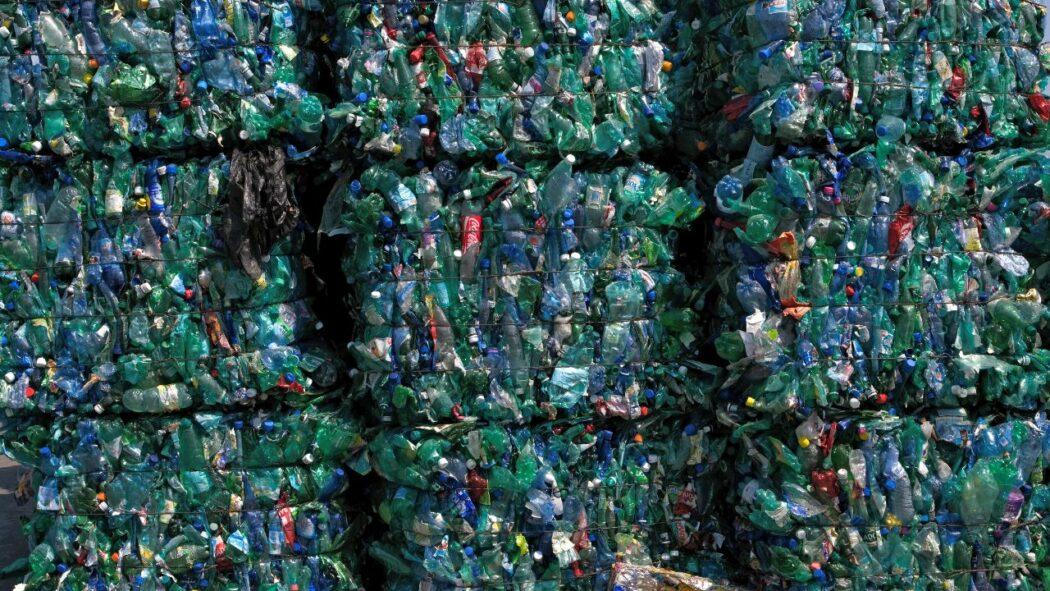€7 billion is being poured into chemical recycling – is it worth it?

Shutterstock
Advocates believe new recycling technology can help avert a plastic waste crisis, but critics warn that processes remain unproven and overly expensive.
On a sunny April afternoon, Markus Klatte climbs the ladder to the roof of his chemical recycling factory. At the top, he looks down on the industrial park in the west of Frankfurt, where Höchst AG once drove German plastics production. Today, Klatte wants his plant to deal with its legacy: the vast quantities of plastic that are still burned in incineration plants across Europe.
For a few months now, Klatte’s company, Arcus Greencycling, has operated one of the first industrial-sized pyrolysis plants in Germany. The plant converts aluminium plastic into oil which is then sent to BASF Group to produce plastic again.
“We can help where conventional recycling cannot,” Klatte enthuses as he walks past the bags from which his machine consumes soiled waste plastic. It is material that conventional recycling plants cannot recycle. “Recycling rates are poor,” he adds. “We want to help with that. We need chemical recycling.”
The EU has made recycling a priority in its Green Deal. The future circular economy, in which plastic waste is turned into new plastic, is also to be built on this. The goal is to “close the loop”, said Commission Vice-President Frans Timmermans in 2015 when presenting the Circular Economy Action Plan. The Circular Plastics Alliance followed in 2018 and again it was Timmermans who presented the initiative, declaring that Europe was “leading” with its circular economy efforts.
But the EU is far from achieving its goals. While recyclers have long had efficient processes to create new products from scrap metal and glass, they have a harder time with plastic. The problem is that not all plastics are the same. Different polymers with different properties are grouped under the term plastic. And plastic producers are increasingly bonding the various materials to make multilayer packaging. But conventional recyclers cannot process this type of packaging. Around 60 per cent of Europe’s plastic packaging waste is still not recycled, much of it instead is sent to incineration plants.
This is what companies like Klatte’s business partner BASF now claim they can solve. Industry associations in Brussels such as The European Chemical Industry Council and Plastics Europe aggressively promote the new technology. “We can close the loop,” a lobbyist told the EU Commission in 2019, according to meeting minutes obtained by Investigate Europe.
Zero Waste Europe has tracked for years how corporations use their power to pressure EU institutions. “The concept of chemical recycling is not new,” says Janek Vähk from the NGO. “The industry has been promoting it for decades.”
BASF first operated a pyrolysis plant at the beginning of the millennium, which converted waste plastic into oil. But this and similar plants soon disappeared. The oil produced could not compete with the cheap crude oil of the time. But chemical companies have renewed hope since the EU launched its circular economy plans.
In another meeting, the chemical industry said they supported “the need to be ambitious in terms of circularity”, telling the Commission that the process is complimentary to existing methods. It also announced massive investments in the future. By 2030, the industry is expected to have invested €7.2 billion in chemical-led recycling processes. They claim that by then, plants should be producing 3.4 million tonnes of recycled plastic. Only a handful of chemical recycling sites are currently operational in Europe but plans for new plants in Germany, Poland and the UK point to a growing interest.
Traditional mechanical recyclers today are not only unable to deal with multilayer packaging but also with plastic waste too dirty to be processed further. The EU’s Joint Research Centre concluded in a study that waste management systems in EU countries are “poor”. Only 38 per cent of plastic packaging was recycled last year, according to Eurostat.
But some industry insiders doubt that chemical recycling is the solution. “There is a correlation between the quality of the waste that goes into the process and the oil they end up with,” says a waste expert who does not want to be named. “There is a gap between the pyrolysis oil and the specifications that the chemical industry needs in their plants for virgin plastics.” The purer the raw material the better the result. But conventional recyclers also need same.
“Competition with existing recycling technologies should be avoided,” says Julia Vogel from UBA, Germany’s Federal Environment Agency. “There are still many unanswered questions.” For Vogel, it is far from proven that pyrolysis plants can process heavily polluted plastic. UBA started a four-year research project on the new technology in 2020 to hopefully clarify such uncertainties. “Due to the precarious data situation, however,” their initial report assessed, “an evaluation of chemical recycling processes is currently still difficult.” Zero Waste Europe’s Vähk agrees: “So far it is completely unclear how sustainable pyrolysis is.”
Chemical firms are quick to dismiss such concerns. Their websites are filled with green fields and blue oceans and promises of a new technology that can save the planet: less burning, less oil imports, less CO2 emissions. This is because the chemical recycling plants produce not only pyrolysis oil but other materials that can later be used as fuel.
With firms set to pour billions of euros into the new technology over the coming years, lobby groups are demanding “investment security” from the EU Commission. For the chemical industry, this would mean the EU allowing for oil and other materials generated during the process to be counted as recyclable materials on top of the actual recycled plastics. They call this model “free allocation”.
During pyrolysis, approximately 30 to 40 per cent of the input material will eventually become plastic again. The material losses are five to 10 per cent, while the remaining materials can also be used by chemical firms to produce fuel again. If the EU approves this free allocation approach then not only what is turned back into plastic could be counted as recycled material, but almost everything else.
Without the Commission’s backing, however, companies are unlikely to push for chemical recycling for one simple reason: it’s not worth it. Crude oil is too cheap, energy costs are too high and the technology is too expensive compared to virgin plastic production and traditional recycling. Pyrolysis-led chemical recycling, according to the JRC study, will only break-even by 2033 under favourable conditions and after technological innovation.
But with the EU eager to hit its circular economy goals and a new regulation set to make it mandatory for all food packaging to contain at least 10 per cent of recycled plastics by 2030, plants like Markus Klatte’s in Germany could be increasingly common across Europe. Whether they will be worth it, is still unknown.
Editor: Chris Matthews
For a few months now, Klatte’s company, Arcus Greencycling, has operated one of the first industrial-sized pyrolysis plants in Germany. The plant converts aluminium plastic into oil which is then sent to BASF Group to produce plastic again.
“We can help where conventional recycling cannot,” Klatte enthuses as he walks past the bags from which his machine consumes soiled waste plastic. It is material that conventional recycling plants cannot recycle. “Recycling rates are poor,” he adds. “We want to help with that. We need chemical recycling.”
The EU has made recycling a priority in its Green Deal. The future circular economy, in which plastic waste is turned into new plastic, is also to be built on this. The goal is to “close the loop”, said Commission Vice-President Frans Timmermans in 2015 when presenting the Circular Economy Action Plan. The Circular Plastics Alliance followed in 2018 and again it was Timmermans who presented the initiative, declaring that Europe was “leading” with its circular economy efforts.
But the EU is far from achieving its goals. While recyclers have long had efficient processes to create new products from scrap metal and glass, they have a harder time with plastic. The problem is that not all plastics are the same. Different polymers with different properties are grouped under the term plastic. And plastic producers are increasingly bonding the various materials to make multilayer packaging. But conventional recyclers cannot process this type of packaging. Around 60 per cent of Europe’s plastic packaging waste is still not recycled, much of it instead is sent to incineration plants.
This is what companies like Klatte’s business partner BASF now claim they can solve. Industry associations in Brussels such as The European Chemical Industry Council and Plastics Europe aggressively promote the new technology. “We can close the loop,” a lobbyist told the EU Commission in 2019, according to meeting minutes obtained by Investigate Europe.
Zero Waste Europe has tracked for years how corporations use their power to pressure EU institutions. “The concept of chemical recycling is not new,” says Janek Vähk from the NGO. “The industry has been promoting it for decades.”
BASF first operated a pyrolysis plant at the beginning of the millennium, which converted waste plastic into oil. But this and similar plants soon disappeared. The oil produced could not compete with the cheap crude oil of the time. But chemical companies have renewed hope since the EU launched its circular economy plans.
In another meeting, the chemical industry said they supported “the need to be ambitious in terms of circularity”, telling the Commission that the process is complimentary to existing methods. It also announced massive investments in the future. By 2030, the industry is expected to have invested €7.2 billion in chemical-led recycling processes. They claim that by then, plants should be producing 3.4 million tonnes of recycled plastic. Only a handful of chemical recycling sites are currently operational in Europe but plans for new plants in Germany, Poland and the UK point to a growing interest.
Traditional mechanical recyclers today are not only unable to deal with multilayer packaging but also with plastic waste too dirty to be processed further. The EU’s Joint Research Centre concluded in a study that waste management systems in EU countries are “poor”. Only 38 per cent of plastic packaging was recycled last year, according to Eurostat.
But some industry insiders doubt that chemical recycling is the solution. “There is a correlation between the quality of the waste that goes into the process and the oil they end up with,” says a waste expert who does not want to be named. “There is a gap between the pyrolysis oil and the specifications that the chemical industry needs in their plants for virgin plastics.” The purer the raw material the better the result. But conventional recyclers also need same.
“Competition with existing recycling technologies should be avoided,” says Julia Vogel from UBA, Germany’s Federal Environment Agency. “There are still many unanswered questions.” For Vogel, it is far from proven that pyrolysis plants can process heavily polluted plastic. UBA started a four-year research project on the new technology in 2020 to hopefully clarify such uncertainties. “Due to the precarious data situation, however,” their initial report assessed, “an evaluation of chemical recycling processes is currently still difficult.” Zero Waste Europe’s Vähk agrees: “So far it is completely unclear how sustainable pyrolysis is.”
Chemical firms are quick to dismiss such concerns. Their websites are filled with green fields and blue oceans and promises of a new technology that can save the planet: less burning, less oil imports, less CO2 emissions. This is because the chemical recycling plants produce not only pyrolysis oil but other materials that can later be used as fuel.
With firms set to pour billions of euros into the new technology over the coming years, lobby groups are demanding “investment security” from the EU Commission. For the chemical industry, this would mean the EU allowing for oil and other materials generated during the process to be counted as recyclable materials on top of the actual recycled plastics. They call this model “free allocation”.
During pyrolysis, approximately 30 to 40 per cent of the input material will eventually become plastic again. The material losses are five to 10 per cent, while the remaining materials can also be used by chemical firms to produce fuel again. If the EU approves this free allocation approach then not only what is turned back into plastic could be counted as recycled material, but almost everything else.
Without the Commission’s backing, however, companies are unlikely to push for chemical recycling for one simple reason: it’s not worth it. Crude oil is too cheap, energy costs are too high and the technology is too expensive compared to virgin plastic production and traditional recycling. Pyrolysis-led chemical recycling, according to the JRC study, will only break-even by 2033 under favourable conditions and after technological innovation.
But with the EU eager to hit its circular economy goals and a new regulation set to make it mandatory for all food packaging to contain at least 10 per cent of recycled plastics by 2030, plants like Markus Klatte’s in Germany could be increasingly common across Europe. Whether they will be worth it, is still unknown.
Editor: Chris Matthews





